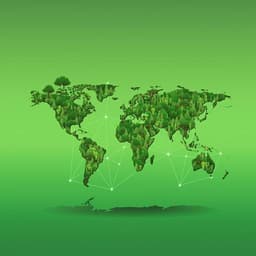
Environmental Studies and Forestry
Shifts in regional water availability due to global tree restoration
A. J. H. V. Dijke, M. Herold, et al.
This innovative study, conducted by a team including Anne J. Hoek van Dijke and Martin Herold, delves into the surprising effects of large-scale tree restoration on global water availability. With findings indicating that while some regions could see a 6% boost in water resources, others might face alarming declines up to 38%, this research calls for a reevaluation of tree restoration strategies.
~3 min • Beginner • English
Introduction
The UN Decade on Ecosystem Restoration highlights large-scale tree restoration as a key climate mitigation and biodiversity strategy, with recent estimates suggesting up to 900 million hectares of potential additional tree cover without encroaching on agriculture or urban areas. While restoration offers carbon and ecosystem service benefits, its hydrological impacts remain uncertain and are often overlooked in planning. Traditionally, paired catchment studies consistently show that afforestation increases annual evaporation and reduces streamflow due to deeper rooting, higher leaf area, increased interception, lower albedo, and greater aerodynamic roughness. However, large-scale analyses suggest more complex outcomes because increased evaporation can recycle back to land and enhance downwind precipitation via atmospheric moisture transport. The central research question is how global-scale tree restoration affects regional water availability and streamflow when both the direct (local increased evaporation) and indirect (downwind precipitation from moisture recycling) effects are accounted for. The study aims to quantify these effects under current climate using a data-driven Budyko modeling ensemble and a global moisture recycling dataset to inform restoration strategies that consider hydrological consequences locally and remotely.
Literature Review
Paired catchment and basin-scale studies across climates and species consistently report increased evaporation and reduced water yield following forest cover increases, though magnitudes vary with climate, species, and stand age (e.g., Brown 2005; Bosch & Hewlett 1982; Farley et al. 2005; Jackson et al. 2005; Zhang et al. 2001; Filoso et al. 2017). These effects are attributed to biophysical differences between forests and other covers (rooting depth, LAI, interception, albedo, roughness). In contrast, regional to global studies have highlighted atmospheric moisture recycling, where increased evaporation can enhance precipitation downwind, potentially offsetting local losses and influencing hydrology at continental scales (e.g., Spracklen et al. 2012; Keys et al. 2016; Meier et al. 2021). Teleconnections indicate that forest cover changes in the Amazon can affect precipitation far afield (Lawrence & Vandecar 2015). Reviews emphasize the need to move from demand-side (evaporation increase) to supply-side (precipitation via recycling) perspectives (Ellison et al. 2012) and to integrate moisture recycling into land-cover change assessments (te Wierik et al. 2021). Despite advances, no prior study has quantified global tree restoration impacts on water availability while jointly accounting for direct evaporation increases and indirect precipitation via recycling using high-resolution, observation-informed datasets.
Methodology
The study evaluates a realistic large-scale tree restoration scenario: adding 900 million hectares of tree cover where trees could naturally grow without displacing cropland or urban areas (global tree-restoration potential). Hydrological impacts are quantified for evaporation (E), precipitation (P), water availability (defined as P − E on an annual basis), and streamflow (Q; basin accumulation of water availability). The workflow comprises four steps:
1) Baseline E and Q: Compute pre-restoration E and Q using six Budyko-type models that partition long-term mean P into E and Q as functions of aridity (E0/P) and a vegetation parameter ω calibrated separately for forests and non-forests. Inputs: climatological precipitation (MSWEP v2.8), potential evaporation (WorldClim v2), and current tree cover (Hansen v1.7). Spatial resolution ~0.00833° (~1 km).
2) Direct restoration effect (no recycling): Update tree cover by adding the restoration potential (capped at 100% cover) and recompute E and Q with the Budyko models, holding P and E0 fixed, to obtain ΔE and ΔQ without recycling. This local approach assumes restoration increases E but does not yet modify P.
3) Precipitation from moisture recycling: Use the UTrack Lagrangian moisture-tracking dataset (0.5°) to route the additional evaporated water (ΔE from step 2) to downwind land pixels, yielding ΔP due to recycling. Monthly UTrack recycling climatologies are aggregated to yearly means for compatibility with Budyko’s annual framework (acknowledging some seasonal-directionality loss). Assumption: increased E amplifies current recycling patterns; changes in circulation or recycling pathways due to land-cover change are not modeled.
4) Full effect with recycling: Recompute E and Q with Budyko models using P + ΔP from step 3 and post-restoration tree cover to obtain E and Q after restoration with recycling.
Model ensemble and validation: Six Budyko formulations are used (including Zhang, Fu calibrations by Zhang, Zhou, and Teuling, and a multi-equation mean with vegetation parameters per Oudin et al.). The vegetation parameterization distinguishes forest vs grass/other cover and is derived from large multi-basin datasets and lysimeters. Results are aggregated to 0.5° for recycling computations and evaluated at 0.1°/0.5° for mapping. Multi-model Q under current conditions is validated against GRDC streamflow for 19 large river basins, showing good agreement except for Murray-Darling and Colorado, likely due to human water withdrawals not represented by Budyko.
Key assumptions and data: Potential evaporation is assumed unchanged by restoration; land–atmosphere feedbacks on circulation, convection, and recycling patterns are excluded; Budyko assumes long-term steady state with negligible storage change. Datasets include MSWEP precipitation, WorldClim potential evaporation, Hansen tree cover, global tree-restoration potential, UTrack recycling, GRDC streamflow, and HydroSHEDS basin boundaries.
Key Findings
- Global flux changes:
- Direct local effect (no recycling): Tree restoration increases terrestrial evaporation by 8.2 ± 5.5 mm yr⁻¹ on average (+1.2%), with a highly skewed distribution and local increases >250 mm yr⁻¹ in parts of tropical South America.
- Moisture recycling: About 68% of the extra evaporated water rains out over land. Continental-scale recycling raises terrestrial precipitation by 4.8 ± 3.1 mm yr⁻¹ on average (+0.7%).
- Water availability (P − E): Without recycling, global mean water availability decreases by 8.2 ± 5.3 mm yr⁻¹. Including recycling, the decrease is reduced to 5.3 ± 5.6 mm yr⁻¹. Spatially, changes range from decreases up to 38% to increases up to 6%. Roughly half of Earth’s land (47%) experiences sufficient recycling to offset local E increases, yielding slight increases in water availability. Histograms indicate 89% (no recycling) and 91% (with recycling) of land pixels fall within −20 to +10 mm yr⁻¹ change.
- Spatial patterns:
- Regions with high restoration potential but limited upwind/lateral recycling (e.g., the United Kingdom under prevailing westerlies) show substantial streamflow decreases.
- Low latitudes (tropics) and the Tibetan Plateau can see water availability increases due to strong local recycling (convection, orographic lift) and shorter moisture travel distances.
- River basin impacts (ensemble with recycling):
- Enhanced evaporation reduces streamflow in all basins by up to ~9%, but in several tropical basins strong recycling nearly compensates losses, yielding small net changes.
- Despite recycling, most major river basins experience net streamflow declines (e.g., Mississippi, Rhine, Danube, Niger), whereas some (e.g., Amazon, Congo) see much smaller reductions due to higher recycling fractions.
- Water scarcity implications:
- Several ‘hot spots’ for restoration face notable reductions in annual water availability because recycling does not fully offset increased E.
- Some regions already experiencing seasonal water scarcity may see further annual declines; others with little local restoration potential could benefit from imported recycled moisture. Dry-season outcomes may differ from annual means due to improved infiltration and soil storage under trees, potentially enhancing baseflow or soil water availability seasonally.
Discussion
By explicitly combining direct evaporation increases with indirect precipitation gains from moisture recycling, the study demonstrates that large-scale tree restoration induces complex, regionally heterogeneous shifts in water availability and streamflow. The analysis shows a global net reduction in annual water availability over land despite recycling, addressing the central question by quantifying where and to what extent recycling offsets local evaporative losses. The findings underscore that restoration benefits are not hydrologically uniform: downwind gains may occur where recycling is strong, while upwind or ocean-dominated moisture source regions may incur net losses. For river basins, even modest percentage reductions in Q can have significant water management implications, particularly in already stressed systems.
The results emphasize the importance of integrating hydrological considerations into restoration planning. Strategic placement could reduce adverse impacts on water-limited regions while leveraging upwind restoration to enhance downwind precipitation. While the study operates at annual scales, it notes that trees can increase infiltration and soil storage, potentially improving dry-season water availability even where annual totals decline. Nonetheless, omitted land–atmosphere feedbacks (e.g., altered circulation, convection) could modify local precipitation responses, but are unlikely to overturn the general conclusion of a global net decline under the scenario analyzed.
Conclusion
Large-scale tree restoration substantially redistributes terrestrial water fluxes. Under current climate, restoring 900 Mha of trees increases evaporation and, via moisture recycling, precipitation over land, but yields a global net decrease in annual water availability and widespread streamflow reductions, with strong spatial variability. The study’s main contribution is a global, observation-informed quantification that jointly accounts for direct and indirect hydrological effects, revealing where recycling can offset local losses and where it cannot. Future research should: (1) integrate dynamic land–atmosphere feedbacks and potential changes in atmospheric circulation and recycling pathways into coupled modeling frameworks; (2) resolve seasonal effects to capture dry-season benefits and risks; (3) assess interactions with climate change, including shifts in restoration potential, aridity, and storm tracks; and (4) support ‘smart’ restoration strategies that explicitly consider upwind–downwind water linkages to safeguard or enhance water security locally and remotely.
Limitations
- Land–atmosphere feedbacks and circulation changes (e.g., altered convergence, convection, jet stream position, Hadley cell shifts) due to restoration are not represented; the approach assumes amplification of current recycling patterns.
- Calculations are annual; seasonal directionality and magnitude of moisture transport are simplified by aggregating monthly recycling to yearly means, potentially missing intra-annual variations.
- Budyko framework assumes long-term steady state with negligible storage changes; potential evaporation is held constant; effects of increased canopy on local microclimate and E0 are not included.
- Validation indicates biases in basins with substantial human water withdrawals (e.g., Murray-Darling, Colorado), which Budyko does not capture.
- The analysis is performed under current climate; future warming could reduce restoration potential, increase potential evaporation and precipitation, and alter circulation and recycling patterns, affecting results.
- Land-cover class simplifications group non-tree covers into a grass/other category; heterogeneity in bare/shrub/built-up evaporation is assumed negligible at the global scale.
Related Publications
Explore these studies to deepen your understanding of the subject.







